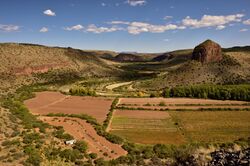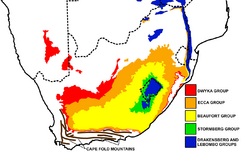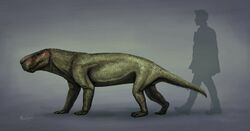Earth:Balfour Formation
| Balfour Formation Stratigraphic range: Lopingian | |
|---|---|
 Outcrops of the Balfour Formation are found in the hillsides surrounding Nieu-Bethesda, Eastern Cape, South Africa | |
| Type | Geological formation |
| Unit of | Adelaide Subgroup, Beaufort Group |
| Sub-units | Oudeberg Member, Daggaboersnek Member, Ripplemead Member, Elandsberg Member, Palingkloof Member |
| Underlies | Katberg Formation |
| Overlies | Middleton Formation |
| Thickness | up to 2,150 m (7,050 ft) |
| Lithology | |
| Primary | Mudstone, siltstone |
| Other | Sandstone |
| Location | |
| Region | Northern Cape, Eastern Cape and Free State |
| Country | |
 | |
The Balfour Formation is a geological formation that is found in the Beaufort Group, a major geological group that forms part of the greater Karoo Supergroup in South Africa . The Balfour Formation is the uppermost formation of the Adelaide Subgroup which contains all the Late Permian-aged biozones of the Beaufort Group. Outcrops and exposures of the Balfour Formation are found from east of 24 degrees in the highest mountainous escarpments between Beaufort West and Fraserburg, but most notably in the Winterberg and Sneeuberg mountain ranges near Cradock, the Baviaanskloof river valley, Graaff-Reniet and Nieu Bethesda in the Eastern Cape, and in the southern Free State province.[1][2]
Geology
The Balfour Formation overlies the Middleton Formation of the Adelaide Subgroup and underlies the Katberg Formation of the lower Tarkastad Subgroup, all comprising the greater Beaufort Group. The Balfour Formation is composed of five members which are listed below (from oldest to youngest):
- Oudeberg Member
- Daggaboersnek Member
- Ripplemead Member
- Elandsberg Member
- Palingkloof member
The rocks of the Balfour Formation also incorporate the entire Daptocephalus Assemblage Zone, the lowermost portion of the Lystrosaurus Assemblage Zone,[3] and the uppermost rocks of the Cistecephalus Assemblage Zone.[4] Up until the middle section of the Ripplemead Member, the Balfour Formation correlates with the near contemporaneous Teekloof Formation west of the 24 degrees from Beaufort West westwards, and to the Normadien Formation north of the Orange River. However, the Elandsberg and Palingkloof Members do not have any lateral correlates west of 24 degrees. This is either due to past erosion of the upper, unknown members of the Teekloof Formation or there was a sudden cessation of sedimentary deposition in the western section of the Karoo Basin.[5][6][7][8]
The sedimentary rocks of this formation are composed predominantly of alternating greenish-grey, bluish-grey, and grey-ish red mudstone that often contain siltstone lenses. The mudstones are very fine-grained, massive and exhibit blocky weathering. Claystone successions are also found which, along with the mudstones, frequently contain desiccation cracks, raindrop impressions, and calcareous nodules or concretions are found throughout. Rhythmites are also found. Sandstones are less common, but some notable units have been studied in the Balfour Formation. In the lowermost section of the Balfour is a sandstone-rich unit known as the Oudeberg Member. The sandstones in this unit are very fine-grained and are rich in feldspar. Another sandstone unit in the middle of the Balfour Formation is the Daggaboersnek Member which contains thin, tabular sandstones, and ripple structures are common.[9][10]
The presence of these rocks reveal much about the past environment that they were deposited in. The dominance of fine-grained mudstone and less common, fine-grained sandstones indicates that the rock sediments were deposited in a low-energy, fluvial environment, most likely one that had meandering rivers. At the time of sedimentary deposition, the Karoo retroarc foreland system was in an overfilled phase, and purely terrestrial sediments occupied the Karoo Basin at this time. As this formation includes the rocks of both the Cistecephalus, Daptocephalus, Lystrosaurus Assemblage Zones, the Balfour Formation preserves the geological record for the end Permian extinction event. This is important as the end Permian extinction event was the largest mass extinction event in the Earth's history. This was followed by one of the worst biotic crises, which is reflected in the sudden and drastic sedimentary facies changes in the overlying Katberg Formation.[11][12][13][14][15]
Paleontology
Where the Balfour Formation deposits correlate with the Daptocephalus Assemblage Zone, a great diversity of vertebrate fauna are found. This richness in species diversity observed in the Balfour Formation is especially true of dicynodonts as numerous different species of this successful, herbivorous therapsid have been recovered.[16][17] Various species of burnetiamorph biarmosuchians, rubidgeine gorgonopsians, and therocephalian species such as Moschorhinus kitchingi and the earliest cynodont, Charassognathus gracilis, also appear.[18] Parareptile species,[19] namely captorhinids, the Younginiforme Youngina capensis,[20][21] and a variety of temnospondyl amphibians,[22] fishes, and plant fossils such as Glossopteris are likewise found. Glossopteris fossils or leaf impressions are particularly common in the Daggaboersnek Member. The uppermost unit of the Balfour Formation marks the Permian-aged side of the Permian-Triassic boundary. At this point in the biostratigraphy there is a marked drop in species diversity as the Permian-Triassic extinction event began to take its course at the time of sediment deposition.
| Genus | Species | Notes | Images |
|---|---|---|---|
| Moschorhinus | M. kitchingi | ||
| Charassognathus | C. gracilis | ||
| Inostrancevia [23] | I. africana |
Correlation
The Balfour Formation is known to corresponds in age with the Cis-Uralian fauna of Russia [24] and the Sanga do Cabral Formation, Paraná Basin of Brazil . Correlations with other Late Permian - Early Triassic deposits abroad remain inconclusive.
References
- ↑ Rubidge, B. S. (ed.) 1995b. Biostratigraphy of the Beaufort Group (Karoo Supergroup). South African Committee of Stratigraphy. Biostratigraphic Series 1. Pretoria, Council for Geoscience.
- ↑ Catuneanu, O., Elango, H. N. (2001-04-15). "Tectonic control on fluvial styles: the Balfour Formation of the Karoo Basin, South Africa" (in en). Sedimentary Geology 140 (3–4): 291–313. doi:10.1016/S0037-0738(00)00190-1. ISSN 0037-0738. Bibcode: 2001SedG..140..291C.
- ↑ Botha, Jennifer; Smith, Roger M. H. (2007-06-01). "Lystrosaurus species composition across the Permo–Triassic boundary in the Karoo Basin of South Africa" (in en). Lethaia 40 (2): 125–137. doi:10.1111/j.1502-3931.2007.00011.x. ISSN 1502-3931.
- ↑ Kammerer, Christian F.; Bandyopadhyay, Saswati; Ray, Sanghamitra (2016-11-01). "A new taxon of cistecephalid dicynodont from the upper Permian Kundaram Formation of India" (in en). Papers in Palaeontology 2 (4): 569–584. doi:10.1002/spp2.1055. ISSN 2056-2802.
- ↑ Visser, J.N.J. and Dukas, B.A., 1979. Upward-fining fluviatile megacycles in the Beaufort Group north of Graaff-Reinet, Cape Province. Trans. Geol. Soc. S. Afr, 82(149), p.e154.
- ↑ Johnson, M.R.; Vuuren, C.J. Van; Visser, J.N.J.; Cole, D.I.; Wickens, H. De V.; Christie, A.D.M.; Roberts, D.L. (1997-01-01) (in en). Chapter 12 The foreland karoo basin, south africa. 3. 269–317. doi:10.1016/S1874-5997(97)80015-9. ISBN 9780444825711.
- ↑ Rubidge, B. S.; Hancox, P. J.; Catuneanu, O. (1998-12-01). "Reciprocal flexural behaviour and contrasting stratigraphies: a new basin development model for the Karoo retroarc foreland system, South Africa" (in English). Basin Research 10 (4): 417–439. doi:10.1046/j.1365-2117.1998.00078.x. ISSN 1365-2117. Bibcode: 1998BasR...10..417C. http://www.earthdoc.org/publication/publicationdetails/?publication=62697.
- ↑ Katemaunzanga, David; Gunter, Cornelis Janse (2009-10-01). "Lithostratigraphy, Sedimentology, and Provenance of the Balfour Formation (Beaufort Group) in the Fort Beaufort–Alice Area, Eastern Cape Province, South Africa" (in en). Acta Geologica Sinica - English Edition 83 (5): 902–916. doi:10.1111/j.1755-6724.2009.00110.x. ISSN 1755-6724.
- ↑ Viglietti, Pia; Rubidge, Bruce; Malcom Harris Smith, Roger (2017-03-01). "Revised lithostratigraphy of the upper Permian Balfour and Teekloof formations of the main Karoo Basin, South Africa". South African Journal of Geology 120 (1): 45–60. doi:10.25131/gssajg.120.1.45. Bibcode: 2017SAJG..120...45V. https://www.researchgate.net/publication/319543960.
- ↑ Hiller, N., Stavrakis, N. (1984-02-01). "Permo-Triassic fluvial systems in the southeastern Karoo Basin, South Africa" (in en). Palaeogeography, Palaeoclimatology, Palaeoecology 45 (1): 1–21. doi:10.1016/0031-0182(84)90106-8. ISSN 0031-0182. Bibcode: 1984PPP....45....1H.
- ↑ Ward, Peter D.; Koch, Paul L.; Smith, Roger M. H.; MacLeod, Kenneth G. (2000-03-01). "Timing of mammal-like reptile extinctions across the Permian-Triassic boundary in South Africa" (in en). Geology 28 (3): 227–230. doi:10.1130/0091-7613(2000)28<227:TOMREA>2.0.CO;2. ISSN 0091-7613. Bibcode: 2000Geo....28..227M.
- ↑ Ward, Peter D.; Smith, Roger M. H. (2001-12-01). "Pattern of vertebrate extinctions across an event bed at the Permian-Triassic boundary in the Karoo Basin of South Africa" (in en). Geology 29 (12): 1147–1150. doi:10.1130/0091-7613(2001)029<1147:POVEAA>2.0.CO;2. ISSN 0091-7613. Bibcode: 2001Geo....29.1147S.
- ↑ Smith, R. M. H., Botha, J. (2005-09-01). "The recovery of terrestrial vertebrate diversity in the South African Karoo Basin after the end-Permian extinction" (in en). Comptes Rendus Palevol 4 (6–7): 623–636. doi:10.1016/j.crpv.2005.07.005. ISSN 1631-0683. Bibcode: 2005CRPal...4..623S.
- ↑ Smith, R. M. H., Botha, J. (2006-08-01). "Rapid vertebrate recuperation in the Karoo Basin of South Africa following the End-Permian extinction" (in en). Journal of African Earth Sciences 45 (4–5): 502–514. doi:10.1016/j.jafrearsci.2006.04.006. ISSN 1464-343X. Bibcode: 2006JAfES..45..502B.
- ↑ Smith, Roger; Kirschvink, Joseph L.; Garrison, Geoffrey H.; Erwin, Douglas H.; Kock, Michiel O. De; Buick, Roger; Botha, Jennifer; Ward, Peter D. (2005-02-04). "Abrupt and Gradual Extinction Among Late Permian Land Vertebrates in the Karoo Basin, South Africa" (in en). Science 307 (5710): 709–714. doi:10.1126/science.1107068. ISSN 1095-9203. PMID 15661973. Bibcode: 2005Sci...307..709W.
- ↑ Fröbisch, Jörg (2008-11-17). "Global Taxonomic Diversity of Anomodonts (Tetrapoda, Therapsida) and the Terrestrial Rock Record Across the Permian-Triassic Boundary" (in en). PLOS ONE 3 (11): e3733. doi:10.1371/journal.pone.0003733. ISSN 1932-6203. PMID 19011684. Bibcode: 2008PLoSO...3.3733F.
- ↑ Viglietti, P. A., Smith, R. M. H., Angielczyk, K. D., Kammerer, C. F., Fröbisch, J., Rubidge, B. S. (2016-01-01). "The Daptocephalus Assemblage Zone (Lopingian), South Africa: A proposed biostratigraphy based on a new compilation of stratigraphic ranges" (in en). Journal of African Earth Sciences 113: 153–164. doi:10.1016/j.jafrearsci.2015.10.011. ISSN 1464-343X. Bibcode: 2016JAfES.113..153V.
- ↑ Kammerer, Christian F. (2016-01-26). "Systematics of the Rubidgeinae (Therapsida: Gorgonopsia)" (in en). PeerJ 4: e1608. doi:10.7717/peerj.1608. ISSN 2167-8359. PMID 26823998.
- ↑ Dias-Da-Silva, Sérgio; Modesto, Sean Patrick; Schultz, Cesar Leandro (2006). "Canadian Science Publishing". Canadian Journal of Earth Sciences 43 (11): 1685–1693. doi:10.1139/e06-043.
- ↑ Gow, Chris E. (1975). "The morphology and relationships of Youngina capensis Broom and Prolacerta broomi Parrington" (in en). Palaeontologia Africana. ISSN 0078-8554. http://wiredspace.wits.ac.za/handle/10539/16290.
- ↑ Gardner, Nicholas; Holliday, Casey; O’Keefe, F. (2010-11-01). "The Braincase of Youngina Capensis (Reptilia, Diapsida): New Insights from High-Resolution CT Scanning of the Holotype". Biological Sciences Faculty Research. https://mds.marshall.edu/bio_sciences_faculty/45.
- ↑ Damiani, R. J. (2004-01-01). "Temnospondyls from the Beaufort Group (Karoo Basin) of South Africa and Their Biostratigraphy" (in en). Gondwana Research 7 (1): 165–173. doi:10.1016/S1342-937X(05)70315-4. ISSN 1342-937X. Bibcode: 2004GondR...7..165D.
- ↑ Kammerer, Christian F.; Viglietti, Pia A.; Butler, Elize; Botha, Jennifer (2023). "Rapid turnover of top predators in African terrestrial faunas around the Permian-Triassic mass extinction". Current Biology 33 (11): 2283–2290.e3. doi:10.1016/j.cub.2023.04.007. PMID 37220743.
- ↑ Shishkin, M. A.; Ochev, V. G. (1993). "The Permo-Triassic transition and the early Triassic history of the Euramerican tetrapod fauna" (in en). New Mexico Museum of Natural History and Science Bulletin 3: 435–437. https://www.researchgate.net/publication/259443721. Retrieved 2018-12-11.
 |




